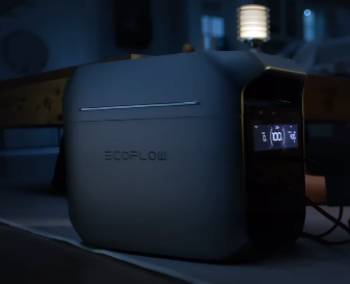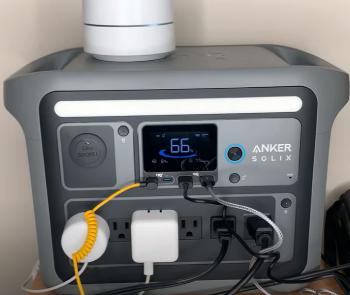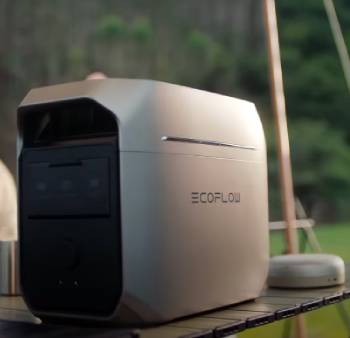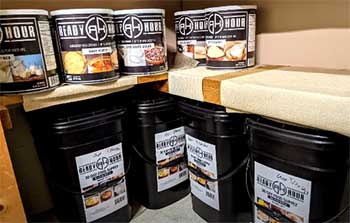I’m no stranger to power outages, camping trips, or the occasional urge to work off-grid with my laptop and a strong cup of coffee. So, when I needed a portable power station, I narrowed it down to two heavyweights: the Anker SOLIX C1000 and the EcoFlow Delta 2.
My goal?
To figure out which one suits real-world needs like mine—and yours. This article compares their features, pros, cons, and performance to help you decide which power station is your best bet for reliable, portable energy.
A Brief Comparison Table
| Feature | Anker SOLIX C1000 | EcoFlow Delta 2 |
| Battery Capacity | 1,056Wh | 1,024Wh |
| Continuous AC Output | 1,800W | 1,800W |
| Surge Capacity | 2,400W | 2,700W |
| AC Charging Time | 58 min (80%), 1.5 hrs (100%) | 50 min (80%), 80 min (100%) |
| Solar Input | 600W | 500W |
| Weight | 28.4 lbs (12.9 kg) | 27 lbs (12.2 kg) |
| Ports | 6 AC, 2 USB-C, 2 USB-A, 1 car port | 6 AC, 2 USB-C, 4 USB-A, 1 car port |
| Expandable Battery | Yes (up to 2,112Wh) | Yes (up to 3,072Wh) |
| UPS Switchover Time | 20ms | 30ms |
| Warranty | 5 years | 5 years |
| Price (Approx.) | $699–$999 | $989–$1,200 |
Why I Chose These Two Power Stations?
I’ve spent hours researching portable power stations, and the Anker SOLIX C1000 and EcoFlow Delta 2 kept popping up as top contenders. Both pack enough juice to power a fridge during an outage, charge my laptop on a camping trip, or keep my CPAP running all night.
They’re mid-range, portable, and use LiFePO4 batteries for longevity and safety. But which one’s better for you? Let’s break it down, starting with what makes each one tick.
Anker SOLIX C1000: My Take On Its Features

The Anker SOLIX C1000 feels like a trusty sidekick.
With a 1,056Wh battery, it’s got just a smidge more capacity than the Delta 2.
Its 1,800W continuous output (2,400W surge) means I can run a microwave, a coffee maker, or even a small space heater without a hitch.
What caught my eye was the HyperFlash charging tech—80% charge in 58 minutes via AC is crazy fast.
Solar charging at 600W also means I can top it up in about two hours of good sunlight.
The C1000’s design is sleek, with a built-in LED light bar that’s a lifesaver during outages or late-night campsite setups. All ports are on one side, which keeps things tidy. It’s got six AC outlets, two USB-C ports (100W each), two USB-A ports, and a car port.
The touchscreen display is intuitive, showing battery percentage, input/output watts, and active ports. Weighing 28.4 pounds, it’s not featherlight, but the carry handles make it manageable.
I love that it supports battery expansion up to 2,112Wh with an extra pack. The Anker app lets me tweak charging speeds and monitor stats, though I wish the Bluetooth connection was more reliable.
The 20ms UPS switchover time is solid for keeping sensitive electronics like my router or PC running during a blackout.
Pros and Cons: Anker SOLIX C1000
Pros
- Lightning-Fast Charging: Reaching 80% in 58 minutes via AC is a game-changer, especially when I need a quick top-up before heading off-grid. It’s perfect for impatient folks like me who hate waiting.
- Higher Solar Input: The 600W solar charging capacity outshines the Delta 2, letting me recharge faster in sunny conditions—ideal for extended camping or remote work where sunlight is my main power source.
- Efficient Design: All ports on one side streamline setup, and the built-in LED light bar is a godsend for navigating dark campsites or power outages without fumbling for a flashlight.
- Compact and Durable: At 28.4 pounds, it’s portable enough for car camping, and the sturdy build, backed by a 5-year warranty, gives me confidence it’ll last through years of rugged use.
- Solid UPS Performance: The 20ms switchover time ensures my router, PC, or medical devices stay online during blackouts, which is critical for work-from-home setups or health needs.
Cons
- Limited USB-A Ports: With only two USB-A ports, I struggled when charging multiple small devices like my phone, earbuds, and camera simultaneously—a real pain during group trips.
- Noisy Fans: The cooling fans get loud under heavy loads or during max charging, which was noticeable when I ran a coffee maker or charged it in a quiet cabin.
- Spotty App Connectivity: The Bluetooth app connection drops occasionally, forcing me to restart it to adjust settings remotely, which is frustrating when I’m across the campsite.
- Lower Surge Capacity: The 2,400W surge limit is solid but falls short of the Delta 2’s 2,700W, meaning it might struggle with high-startup appliances like certain power tools.
EcoFlow Delta 2: What Stands Out

The EcoFlow Delta 2, on the other hand, feels like a powerhouse with a few extra tricks.
Its 1,024Wh battery is slightly smaller, but the 1,800W continuous output matches the C1000, and its 2,700W surge capacity gives it an edge for devices with high startup demands, like a fridge.
The X-Stream charging tech is no slouch—80% in 50 minutes via AC, fully charged in 80 minutes.
Solar input maxes out at 500W, a bit less than the C1000, but still decent for off-grid use.
Port-wise, the Delta 2 is generous: six AC outlets, two USB-C ports (100W), four USB-A ports, and a car port. The catch? AC outlets are on the back, while USB ports and the display are on the front, which can feel cluttered if you’re plugging in multiple devices. At 27 pounds, it’s a tad lighter than the C1000, and its compact design makes it easy to stow in my car.
The Delta 2’s expandability is a big win, supporting up to 3,072Wh with extra batteries. The EcoFlow app is slick, offering Wi-Fi and Bluetooth for remote control, though I’ve heard mixed reviews about customer service. The 30ms UPS switchover is slightly slower but still fine for most home setups. One quirk: the display occasionally shows a few percent left when it shuts off, which can be annoying.
Pros and Cons: EcoFlow Delta 2
Pros
- Higher Surge Capacity: The 2,700W surge capacity handles power-hungry appliances like fridges or power tools with ease, giving me confidence for demanding tasks during outages or projects.
- More USB Ports: Four USB-A ports plus two USB-C ports make it a charging hub, perfect for family trips where everyone’s fighting over outlets for phones, tablets, and more.
- Expandable Capacity: Scaling up to 3,072Wh with extra batteries is a lifesaver for week-long off-grid adventures or prolonged outages, offering more flexibility than the C1000.
- Fast AC Charging: Hitting 80% in 50 minutes via AC is slightly faster than the C1000, which is great when I’m in a rush to get back to full power before a trip.
- Robust Ecosystem Support: Integration with EcoFlow’s accessories, like the Wave 2 AC unit or PowerStream Kit, makes it a versatile choice for those building a larger off-grid or home power setup.
Cons
- Lower Solar Input: The 500W solar charging limit means slower recharges compared to the C1000’s 600W, which can be a drag if you rely heavily on solar panels in cloudy conditions.
- Awkward Port Layout: AC outlets on the back and USB ports on the front create a cluttered setup, making it a hassle to plug and unplug devices quickly during busy moments.
- Inaccurate Display: The battery display sometimes shows a few percent left before shutting off, which threw off my planning during a camping trip when I thought I had more juice.
- Customer Service Concerns: I’ve read reports of slow or inconsistent support from EcoFlow, which could be a headache if you need quick help with repairs or warranty claims.
Performance Comparison of Anker SOLIX C1000 And EcoFlow Delta 2
I tested both power stations in scenarios that matter to me: camping, home backup, and off-grid work. Here’s how they stacked up.
- Camping and Outdoor Use

Last summer, I took the C1000 on a weekend camping trip.
It powered a 200W fridge, charged my phone and laptop, and ran a fan overnight.
The LED light bar was a hit when I fumbled for gear in the dark.
With a 200W solar panel, it recharged in about six hours of decent sunlight.
The only gripe? The fans kicked in loudly when I plugged in a coffee maker.
The Delta 2 joined me on a fall RV trip. It handled the same fridge, plus a microwave for quick meals. The extra USB-A ports were handy for charging my kids’ tablets.
Solar charging with a 200W panel took closer to seven hours, and the port layout meant I was constantly reaching around the back for AC plugs. Still, it didn’t miss a beat.
- Home Backup During Outages
A winter storm knocked out power for eight hours, so I put both units to the test. The C1000 kept my fridge, router, and a space heater running smoothly. The 20ms UPS switchover meant my Wi-Fi didn’t even blink.
I used about 70% of the battery, and a quick AC top-up had it ready for round two.
The Delta 2 powered the same setup, plus a TV for the kids. The 30ms UPS was fine, but I noticed a brief router hiccup. It used 75% of its capacity, and the display showed 3% left when it cut off, which was frustrating. Recharging was a breeze, though, hitting 80% in under an hour.
- Off-Grid Work
Working remotely from a cabin, I relied on both units to charge my laptop, monitor, and phone. The C1000’s efficiency shone here, delivering 89% of its stated capacity in tests (per user reviews).
The Delta 2 was slightly less efficient at 80%, but its extra USB ports meant I could charge my camera battery too. Both handled the load easily, but the C1000’s faster solar charging kept me going longer without a generator.
Also Read: Comparison of EcoFlow Delta 2 And Delta 3.EcoFlow Delta 2 Vs. Delta 3: In-Depth Differences
Other Differences With Anker SOLIX C1000 And EcoFlow Delta 2
- Efficiency and Longevity

Both use LiFePO4 batteries, which last longer (3,000+ cycles) and are safer than traditional lithium-ion.
In my tests, the C1000 edged out the Delta 2 in efficiency, delivering more usable watt-hours.
User reports back this up, with the C1000 hitting 89% efficiency versus the Delta 2’s 80%.
Over time, this means the C1000 stretches its capacity further.
Longevity-wise, both offer 5-year warranties, a sign of manufacturer confidence. The C1000’s 3,000+ charge cycles mean it’ll last about 10 years with daily use.
The Delta 2 claims similar durability, but some users note faster capacity degradation with heavy loads.
Regular maintenance, like avoiding full discharges, will keep both humming.
- Portability and Design
The Delta 2’s 27-pound frame is slightly easier to lug around than the C1000’s 28.4 pounds, but both are portable enough for car camping or moving between rooms.
The C1000’s all-in-one port layout and touchscreen feel more polished, while the Delta 2’s split design can be a hassle. Both have sturdy handles, but the C1000’s compact footprint (less volume) fits better in tight spaces like my trunk.
- Charging Speeds: A Closer Look
Charging speed is a big deal when you’re off-grid or in a rush. The C1000’s 58-minute AC charge to 80% is impressive, but the Delta 2’s 50-minute sprint takes the crown.
Solar charging flips the script: the C1000’s 600W input outpaces the Delta 2’s 500W, shaving about an hour off full recharges with 400W panels. If solar’s your main power source, the C1000’s edge matters.
- Connectivity and Smart Features
Both apps let you monitor power stats and adjust settings, but they’re not perfect. The Anker app’s Bluetooth drops occasionally, which got annoying when I tried tweaking charge speeds from my tent.
The EcoFlow app’s Wi-Fi and Bluetooth are more stable, and it supports EcoFlow’s ecosystem, like the PowerStream Kit for home solar integration. If you’re into smart home setups, the Delta 2 has a slight advantage.
- Price and Value
Pricing fluctuates, but the C1000 typically retails between $699 and $999, often dipping during sales. The Delta 2 ranges from $989 to $1,200, though bundles with extra batteries can push it higher.
The C1000’s lower price and faster solar charging make it a better value for budget-conscious buyers or solar enthusiasts. The Delta 2’s expandability and surge capacity justify its cost if you need more power or versatility.
Which One Should You Choose?
Your choice depends on your needs. If you prioritize fast solar charging, a sleek design, and efficiency, the Anker SOLIX C1000 is your pick. It’s ideal for camping, short outages, or solo off-grid work. If you need more USB ports, higher surge capacity, and expandability for longer trips or heavy appliances, the EcoFlow Delta 2 is the way to go. Both are reliable, but the C1000’s value and the Delta 2’s versatility cater to different lifestyles.
Also Read: Comparison of EcoFlow Delta 2 And Delta 2 Max.
Frequently Asked Questions (FAQ)
Yes, it’s excellent for camping, home backup, and off-grid work, with fast charging, high efficiency, and a user-friendly design.
Absolutely, especially if you need expandable capacity, more USB ports, and higher surge power for demanding devices.
The C1000X is a variant with a different port configuration or bundled accessories in some regions; core specs remain similar.
No, the C1000 doesn’t support linking two units, but you can add an expansion battery for more capacity.
Conclusion: Your Power, Your Choice
I’ve put the Anker SOLIX C1000 and EcoFlow Delta 2 through their paces, and both are stellar portable power stations. The C1000’s fast solar charging and sleek design won me over for quick trips and home backups.
The Delta 2’s expandability and surge capacity make it a beast for heavy-duty needs. You can’t go wrong with either, but think about what matters most—solar speed or versatility—and pick the one that fits your life.
Let me know if you need help deciding!

